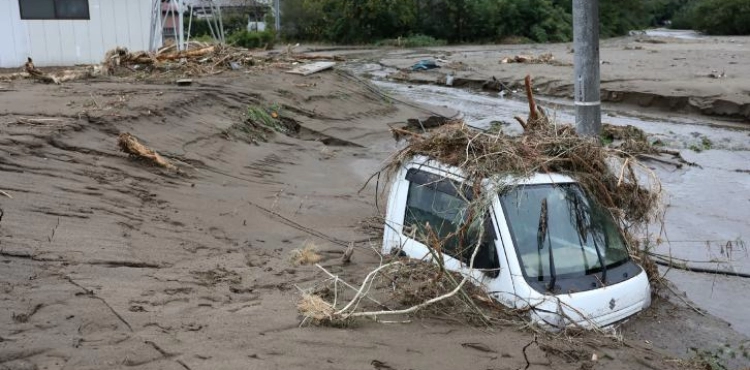Tens of thousands of rescuers continued to work Monday night in Japan in search of survivors of Typhoon Hagiebis that killed 56 people, as renewed rainfall threatened to hamper relief efforts.
Typhoon Hagebes from the Pacific Ocean hit Japan on Saturday evening, with winds of up to 200 km per hour, and preceded by heavy rains in 36 of the 47 Japanese provinces, especially in the central, east and northeast.
Since Saturday, the death toll has continued to rise. According to the Japanese Broadcasting Corporation "NHK" Monday evening, based on figures collected by correspondents on the ground, that 56 people were killed, and 15 others are still missing after the devastating storm.
"So far, many people are still missing," Prime Minister Shinzo Abe said Monday, adding that "relief teams are doing their best to search for and rescue them, working day and night."
The prime minister later pledged that the country would do its utmost for victims and survivors, and ordered the Defense Ministry to call up about 1,000 reservists to help 31,000 troops involved in the search.
But renewed rainfall in the central and eastern parts of the country could hamper night-time searches, while meteorologists warned of the risk of landslides and floods.
Government spokesman Yoshihide Suga called Monday at a press conference for "full vigilance and caution against landslides and river flooding."
In the central Nagano area, one of the worst-hit areas, officials said relief operations were proceeding cautiously.
A resident, Hiroki Yamaguchi, told AFP he was concerned about "the impact of recent rains on relief efforts."
"We will continue operations (relief) and guard against side disasters from the current rains."
On Monday evening, the death toll continued to rise after bodies of cars and houses flooded, flooded rivers and landslides were recovered.
Among the victims were a municipal worker whose car was flooded and seven crew members of a cargo ship that sank in Tokyo Bay on Saturday night, a Japanese Coast Guard spokesman said.
The Coast Guard continues to search for missing crew after rescuing four Chinese, Burmese and Vietnamese nationalities.
There were 176 rivers, especially in northern and eastern Japan, according to media reports.
The cracking of a dam in the Nagano region caused the Chikuma River to overflow in a residential area, flooding buildings up to the second floor.
Television footage showed patients being transported by ambulance from Nagano Hospital, where about 200 people were cut off by flood waters.
Elsewhere, helicopters were used to evacuate survivors who took shelter in roofs and balconies, and boats were used to reach those trapped by water.
On Monday evening, electricity was still cut off for 75,900 housing units and water for 135,000 homes.
Tens of thousands have been evacuated to shelters, and many are still unaware of when they can return to their homes.
In Nagano, a woman told NHK that she had seen the water swept away the entire furniture of her house. "I don´t know if it´s a dream or a reality," she said.
Transportation in the Greater Tokyo area was paralyzed over the weekend, but traffic resumed on Monday.
The organizers of the Japanese Grand Prix stage 17 of the Formula One world championship at the Suzuka Circuit, near Nagoya (center), postponed until Sunday morning program scheduled for the entire Saturday, especially the official tests.
The devastation caused by the hurricane forced the organizers of the rugby world championships in Japan to cancel a number of matches, but the hosts were able to lift morale by beating Scotland on Sunday and qualified for the quarter-finals for the first time in history.
Team captain Michael Leach gave the victory "to everyone who suffers from the typhoon."












